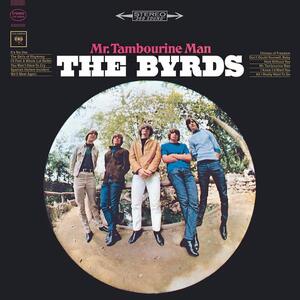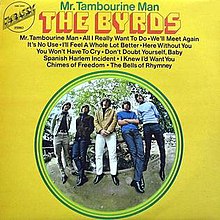Mr. Tambourine Man (album)
| Mr. Tambourine Man | ||||
|---|---|---|---|---|
 |
||||
| Studio album by The Byrds | ||||
| Released | June 21, 1965 | |||
| Recorded | January 20 – April 22, 1965, Columbia Studios, Hollywood, CA | |||
| Genre | Folk rock, pop | |||
| Length | 31:35 | |||
| Label | Columbia | |||
| Producer | Terry Melcher | |||
| The Byrds chronology | ||||
|
||||
| Singles from Mr. Tambourine Man | ||||
|
||||
| Alternative cover | ||||

Cover of the 1974 Embassy Records reissue (EMB 31057)
|
||||
Mr. Tambourine Man is the debut album by the American folk rock band The Byrds and was released in June 1965 on Columbia Records (see 1965 in music). The album, along with the single of the same name, established the band as an internationally successful rock act and was also influential in originating the musical style known as folk rock. The term "folk rock" was, in fact, first coined by the U.S. music press to describe the band's sound in mid-1965, at around the same time that the "Mr. Tambourine Man" single reached the top of the Billboard chart. The single and album also represented the first effective American challenge to the dominance of The Beatles and the British Invasion during the mid-1960s.
The album peaked at No.6 on the Billboard Top LPs chart and reached No.7 in the United Kingdom. The Bob Dylan penned "Mr. Tambourine Man" single was released ahead of the album in April 1965, reaching No.1 on both the Billboard Hot 100 and the UK Singles Chart. A second single from the album, "All I Really Want to Do", also a Dylan cover, was moderately successful in the U.S. but fared better in the United Kingdom, where it reached the Top 10.
Prior to forming The Byrds, most of the members of the band had come from a folk and roots music background, rather than a rock and roll one.Lead guitarist Jim McGuinn had been a folk singer at various New York and Los Angeles folk clubs during the early 1960s and had also served as a sideman with the "collegiate folk" groups The Limeliters and the Chad Mitchell Trio. Additionally, he had spent time as a professional songwriter at the Brill Building under the tutelage of Bobby Darin.Gene Clark had also worked as a solo folk singer and as part of The New Christy Minstrels, while David Crosby had spent time in New York's Greenwich Village as a folk singer and had also been a member of Les Baxter's Balladeers.Chris Hillman's background was more oriented towards bluegrass music than folk, having been a member of the Scottsville Squirrel Barkers, the Golden State Boys (who later renamed themselves The Hillmen), and concurrently with his recruitment into The Byrds, The Green Grass Group.Drummer Michael Clarke's musical pedigree was less auspicious, having played congas in a semi-professional capacity in and around San Francisco and L.A. since leaving his home in Spokane, Washington at the age of 16.
...
Wikipedia
